The world of visual communication thrives on the creativity and skill of graphic designers. Whether you’re interested in a freelance career or working for an agency, success in graphic design requires dedication, a strong foundation, and strategic finesse. This comprehensive guide will provide aspiring and evolving designers with the tools and knowledge to excel in graphic design jobs.
Key Takeaways: Graphic Design Jobs
- Understanding the core principles of graphic design is essential for success.
- Proficiency in industry-standard design software like Adobe Creative Suite is crucial.
- Continuous exploration and inspiration are essential for staying ahead in the field.
- Building a strong portfolio and online presence can help showcase your skills.
- Effective communication and collaboration are key when working with clients.
Building the Foundation: Mastering Design Principles
A successful graphic designer understands the core principles that make visuals not only attractive but also effective communicators. Key areas to focus on include mastering design principles such as balance, contrast, hierarchy, rhythm, and emphasis. These principles allow designers to create visually appealing layouts and guide the viewer’s eye to the intended message.
Balance in design ensures that elements are harmoniously distributed, creating a sense of stability. It can be achieved through symmetrical or asymmetrical arrangements, with each choice creating a different visual impact. By understanding how balance works, designers can create compositions that are visually pleasing and impactful to the viewer.
Contrast, on the other hand, involves the juxtaposition of different elements to create visual interest and to draw attention. It can be achieved through variations in color, size, shape, or texture. By utilizing contrast effectively, designers can guide the viewer’s eye and highlight important elements within a composition.
Hierarchy is all about organizing and prioritizing information based on its importance. By creating a clear hierarchy, designers can guide the viewer’s attention and ensure that the key messages are conveyed effectively. This can be achieved through variations in size, color, or typography.
Rhythm in design refers to the repetition or alternation of elements to create a sense of movement and unity. It helps to establish a visual flow and leads the viewer’s eye through a composition. By utilizing rhythm, designers can create a sense of continuity and engagement within a design.
Emphasis involves directing attention to a specific element or area within a composition. It can be achieved by contrasting elements, utilizing color or size variations, or through the strategic placement of focal points. By effectively utilizing emphasis, designers can create visual impact and guide the viewer’s focus to the most important aspects of a design.
By mastering these design principles, graphic designers can create compelling visual experiences that effectively communicate messages. The practical application of these principles can be seen across various design disciplines, from print and web design to branding and advertising.
Key Design Principles
| Design Principle | Description |
|---|---|
| Balance | Ensuring elements are harmoniously distributed to create stability. |
| Contrast | Juxtaposing different elements to create visual interest and draw attention. |
| Hierarchy | Organizing and prioritizing information based on importance. |
| Rhythm | Repeating or alternating elements to create a sense of movement and unity. |
| Emphasis | Directing attention to a specific element or area within a composition. |
Sharpening Your Skills: Essential Tools of the Trade
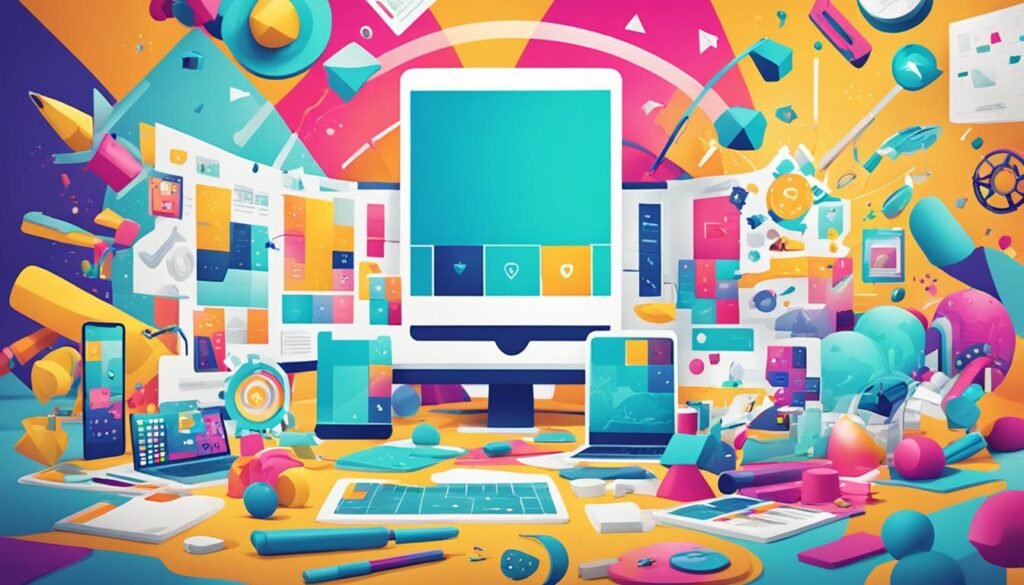
Proficiency in design software is essential for graphic designers. Industry-standard tools include the Adobe Creative Suite, which encompasses Photoshop for image editing, Illustrator for vector graphics, and InDesign for page layout. Other popular tools include Sketch and Figma for UI/UX design and web development, and Canva and Adobe Spark for online design projects.
“Using the right design software can significantly enhance a graphic designer’s workflow and productivity. The Adobe Creative Suite, with its robust tools like Photoshop, Illustrator, and InDesign, provides a comprehensive solution for various design needs. Sketch and Figma are popular choices for their intuitive interface and collaborative features, making them ideal for UI/UX designers. Canva and Adobe Spark offer user-friendly platforms for creating stunning designs online.”
Having a good grasp of these design software tools allows graphic designers to bring their creative visions to life and deliver professional-quality designs. Each tool has its unique features and capabilities, catering to different aspects of the design process.
Adobe Creative Suite
The Adobe Creative Suite is a powerhouse in the design industry and is widely used by professionals. Let’s take a closer look at some of its key software:
| Software | Description |
|---|---|
| Photoshop | Powerful image editing software used for retouching, color correction, and creating visual compositions. |
| Illustrator | A versatile vector graphics editor used for creating scalable artwork, logos, and illustrations. |
| InDesign | An industry-standard page layout program used for designing print and digital publications such as books, magazines, and brochures. |
Sketch and Figma
For UI/UX designers and web developers, Sketch and Figma are go-to tools that offer specialized features for designing user interfaces and collaborating with teams. These tools provide a wealth of resources, plugins, and templates that streamline the design process and ensure pixel-perfect results.
Canva and Adobe Spark
Canva and Adobe Spark are popular choices for creating eye-catching designs online. These platforms offer a wide selection of templates, stock photos, and intuitive editing tools that make it easy for anyone, including non-designers, to create stunning visuals for social media, presentations, and marketing materials.
Having a comprehensive toolkit of design software allows graphic designers to tackle various projects and cater to different client requirements. It’s essential to stay updated with the latest versions of these tools and continue learning new techniques to stay ahead in the rapidly evolving field of graphic design.
Cultivating Your Creative Edge: Inspiration and Exploration
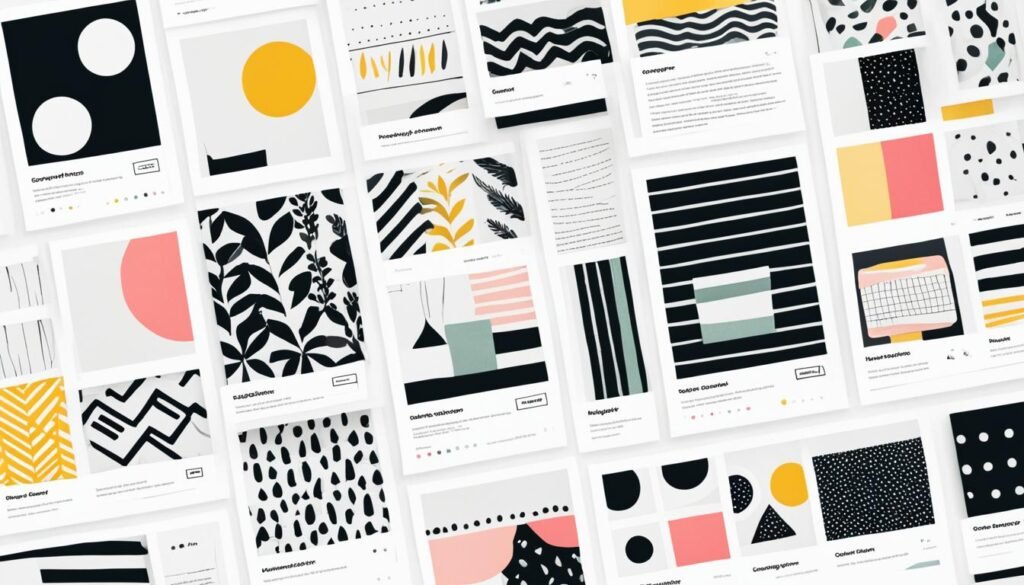
Staying ahead in graphic design requires constant exploration and inspiration. By tapping into various resources, designers can unlock their creative potential and stay up to date with current design trends.
Fueling Creativity with Design Blogs and Publications
Design blogs, such as Communication Arts and Design Week, offer a treasure trove of industry trends, expert insights, and inspirational design examples. These platforms provide designers with a glimpse into the ever-evolving world of graphic design and serve as a source of fresh ideas and perspectives.
Finding Community in Design Communities
Online design communities like Behance and Dribbble are virtual hubs where designers can connect, collaborate, and share their work. These platforms foster a sense of community and offer opportunities for designers to receive feedback, gain visibility, and find inspiration through the works of their peers.
Learning from the Masters: Museums and Art Galleries
Visiting museums and art galleries is not only a feast for the eyes but also a valuable learning experience for graphic designers. By observing the work of established artists, designers can gain insights into effective visual storytelling techniques, composition, color theory, and design principles that have stood the test of time.
“Art is not just about creating visual beauty; it’s also about connecting with emotions, ideas, and stories. Museums and art galleries are treasure troves of inspiration and a testament to the power of visual communication.”
Exploring art exhibitions and immersing oneself in the world of art can spark fresh ideas and generate unique approaches to graphic design projects.
Remember, cultivating your creative edge is an ongoing journey. Regularly engaging with design blogs, participating in design communities, and visiting museums and art galleries can invigorate your design process, inspire innovative solutions, and elevate the quality of your work.
Building Your Brand: The Power of Portfolio and Self-Promotion
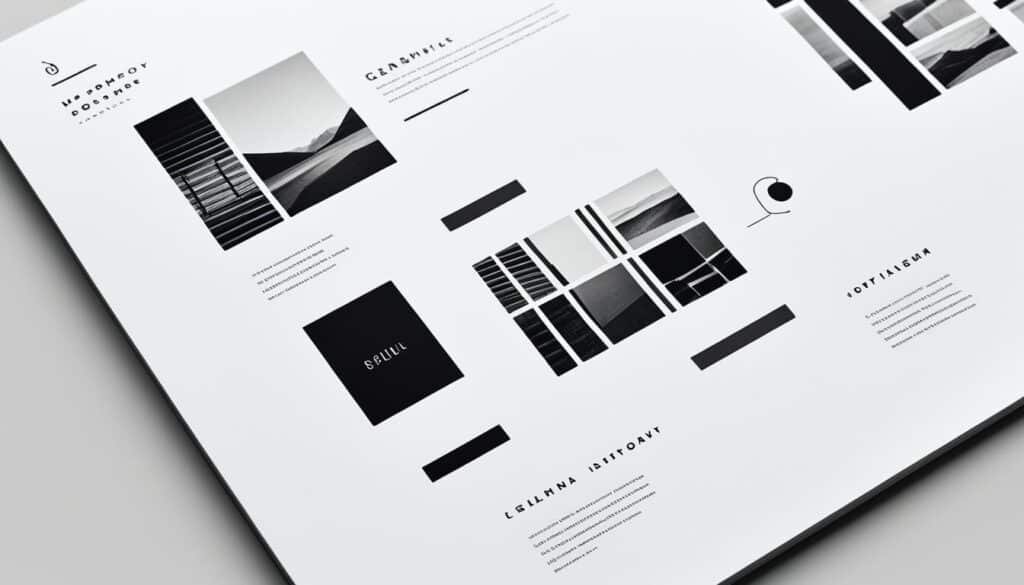
Your graphic design portfolio is an essential tool for showcasing your skills and design philosophy to potential clients or employers. It is a visual representation of your capabilities and a demonstration of your ability to solve design challenges. When curating your portfolio, focus on quality over quantity, selecting your strongest work that showcases your versatility and design expertise.
Investing in creating a professional website or utilizing an online portfolio platform allows you to have an impressive and easily accessible online presence. This digital showcase enables you to present your work in a visually appealing and organized manner, making it easier for potential clients or employers to navigate and evaluate your design skills. Remember to optimize your website or online portfolio using relevant keywords, such as “graphic design portfolio” and “online presence for designers,” to enhance your visibility in search engine results.
Maximize the power of social media platforms like LinkedIn and Instagram to build your brand identity and connect with potential clients. Establishing a consistent and engaging presence on these platforms can help expand your network, increase your visibility among industry professionals, and attract new opportunities. Share your design projects, insights, and industry-related content regularly to establish yourself as an authority in the field of graphic design.
The visual nature of the graphic design industry makes it essential for designers to demonstrate their creative abilities through their online presence. By investing time and effort into building a compelling portfolio and utilizing self-promotion strategies, you can effectively showcase your design skills, attract clients, and further establish your brand in the industry.
Tips for Building a Powerful Graphic Design Portfolio
| Tips | Explanation |
|---|---|
| Showcase your best work | Select a variety of projects that highlight your skills and expertise. Include a mix of different design categories to demonstrate versatility. |
| Organize and categorize your projects | Create logical sections within your portfolio, making it easy for visitors to navigate and explore your work. |
| Provide project details | Include descriptions, project objectives, and the problem-solving approach you employed for each project. This helps potential clients understand your design process. |
| Show your process | Include sketches, wireframes, and other process documentation to provide insights into your design thinking and problem-solving abilities. |
| Highlight client feedback and testimonials | Include client testimonials or excerpts from positive feedback you’ve received, showcasing your professionalism and the impact of your design work. |
| Optimize for mobile | Ensure your portfolio is responsive and mobile-friendly, as many people access websites and portfolios through their smartphones or tablets. |
| Keep it updated | Regularly add new projects, remove outdated work, and make sure your portfolio reflects your current skills and design aesthetic. |
Communication is Key: The Art of Client Collaboration

Effective design goes hand in hand with effective communication. As a graphic designer, it is crucial to understand your client’s needs, brand vision, and target audience. By actively listening and engaging in clear communication, you can ensure that your design work aligns seamlessly with their goals and objectives.
Active listening plays a pivotal role in client collaboration. By truly listening to your clients, you are able to grasp their unique requirements, preferences, and concerns. This allows you to translate their vision into visually compelling designs that effectively communicate their message. The ability to actively listen not only strengthens your relationship with the client but also helps you deliver the best possible outcomes.
“Good communication is as stimulating as black coffee and just as hard to sleep after.” – Anne Morrow Lindbergh
Engaging in clear communication with your clients is equally important. Clear communication ensures that there are no misunderstandings or misinterpretations during the design process. It involves effectively conveying your ideas, presenting concepts in a concise manner, and seeking clarification when necessary. By establishing open and honest lines of communication, you can foster a collaborative environment that leads to successful design outcomes.
Embracing feedback is a crucial aspect of client collaboration. Constructive criticism can provide valuable insights and perspectives that help you refine your work. By being open to feedback and suggestions, you demonstrate your commitment to creating designs that fulfill your clients’ expectations. Embracing feedback also builds trust and strengthens the client-designer relationship, paving the way for long-term partnerships.
Building strong client relationships is an integral part of a graphic designer’s success. Client collaboration goes beyond the role of a mere service provider; it involves building rapport, trust, and understanding. By nurturing these relationships, you are more likely to receive repeat business and referrals, which are vital for sustaining a thriving design career.
The Benefits of Effective Communication and Client Collaboration
When you prioritize communication and client collaboration, you unlock a range of benefits:
- Greater clarity and alignment in the design process
- Improved client satisfaction and retention
- More accurate and impactful designs
- Opportunities for creativity and innovation
- Enhanced reputation and industry recognition
Remember, effective communication and client collaboration are not just valuable skills; they are essential pillars of success for any graphic designer.
Techniques for Effective Communication in Client Collaboration
| Technique | Description |
|---|---|
| Active Listening | Engage in attentive listening and demonstrate understanding |
| Clear and Concise Communication | Ensure your message is effectively conveyed and understood |
| Collaborative Problem-Solving | Work together to find creative solutions |
| Openness to Feedback | Welcome feedback and use it to improve your work |
| Regular Check-Ins | Keep the lines of communication open throughout the design process |
The Business of Design: Staying Ahead in a Competitive Landscape
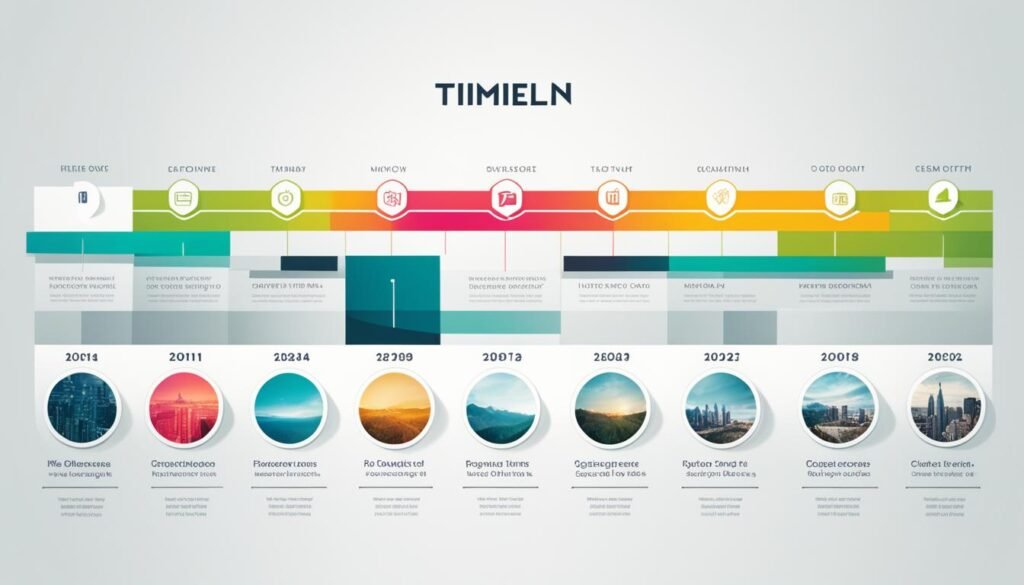
In the fast-paced world of graphic design, staying ahead and maintaining a competitive edge is essential. Lifelong learning is the key to success in this ever-evolving industry.
Design trends, software advancements, and emerging technologies like AR/VR are constantly reshaping the landscape. As a graphic designer, it’s crucial to stay updated with the latest innovations and explore new possibilities.
Consider specializing in a specific design area to cater to niche market needs. UI/UX design or motion graphics are just a couple of examples. By honing your skills in these areas, you can become a sought-after expert in a particular field.
Furthermore, building a strong professional network is vital. By attending industry events and connecting with other designers, you can foster collaboration, share knowledge, and discover new opportunities. Collaborations often lead to innovation and fresh perspectives, pushing your work to new heights.
Design is a collaborative discipline, and embracing collaboration is key to success. By forming connections and building strong relationships with clients, colleagues, and other industry professionals, you not only expand your network but also open doors to exciting projects and collaborations.
Now, to visually illustrate the breadth of design trends over the years, take a look at the following timeline:
| Year | Design Trend |
|---|---|
| 2000 | Skeuomorphism |
| 2005 | Web 2.0 |
| 2010 | Flat Design |
| 2015 | Material Design |
| 2020 | Neumorphism |
This timeline showcases some of the prominent design trends that have shaped the industry. By keeping up with these trends, you can create designs that align with current aesthetics and user expectations.
In summary, lifelong learning, specialization, building a strong network, and embracing innovation are the pillars of staying ahead in the competitive landscape of graphic design. By adopting these practices, you can thrive in this dynamic industry and make a lasting impact with your creative work.
The Business of You: Freelancing vs. Agency Life

When considering a career in graphic design, one important decision you’ll need to make is whether to pursue freelance work or join an agency. This decision will shape your work environment, income structure, and overall workload. Let’s explore the differences between being a freelance graphic designer and working for an agency, so you can make an informed choice that aligns with your goals and aspirations.
The Freedom of Freelancing
As a freelance graphic designer, you have the freedom to choose the projects you work on, allowing you to pursue your interests and showcase your unique style and skills. You have more control over your schedule, giving you the flexibility to work when and where you prefer.
However, freelancing comes with its own set of challenges. Finding clients and securing projects can be time-consuming and requires effective self-promotion and marketing. Additionally, as a freelancer, you’ll be responsible for handling administrative tasks such as invoicing, contracts, and project management.
The Collaborative Environment of Agency Life
Working as an agency graphic designer offers a collaborative and dynamic environment. Agencies often have diverse teams consisting of designers, art directors, copywriters, and project managers. This allows for rich collaboration, exposure to different perspectives, and the opportunity to work on large-scale projects with high-profile clients.
Furthermore, agencies provide a more stable income structure, as you’ll receive a salary or regular pay for your work. In some cases, agency graphic designers may have the potential to earn higher incomes compared to freelancers who rely on project-based payments.
How to Choose
Deciding between freelance graphic design and agency life depends on your personal preferences, work style, and circumstances. Consider the following factors:
- Your need for flexibility and independence
- Your comfort level with self-promotion and client acquisition
- Your desire for collaboration and exposure to diverse projects
- Your preference for stability and a steady income
Ultimately, both freelancing and agency work can lead to successful careers in graphic design. It’s important to assess your goals and priorities to determine which path is the best fit for you.
Remember, no matter which path you choose, your dedication, creativity, and ability to consistently deliver high-quality designs will be the key to your success.
Building Your Value: Investing in Professional Development
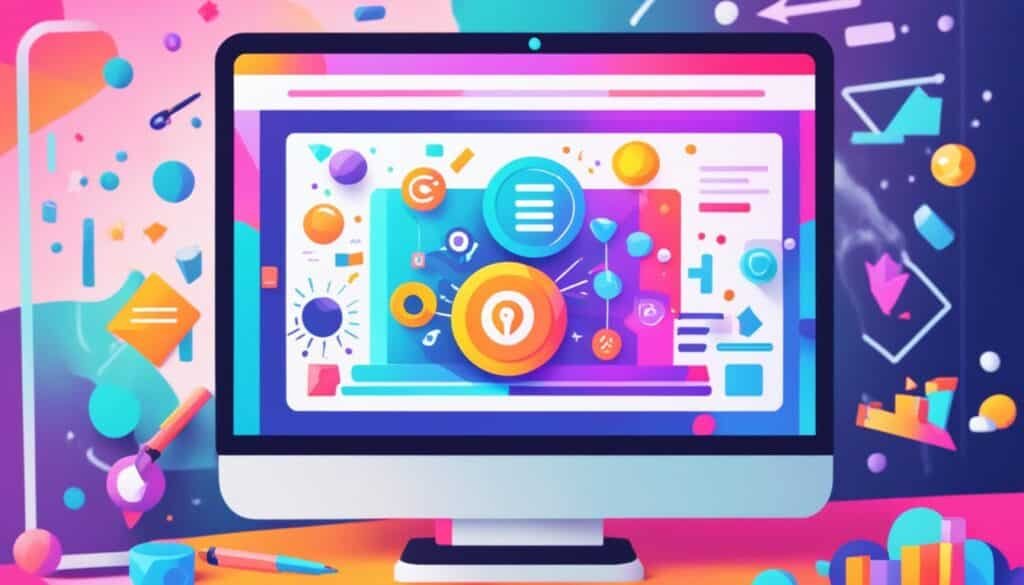
As a graphic designer, investing in your professional development is crucial for personal growth and staying ahead in the industry. By continuously enhancing your skills and staying updated with the latest trends, you can position yourself as a valuable asset. Here are a few ways to invest in your professional development:
1. Online Design Courses
Online design courses provide a flexible and convenient way to expand your knowledge and sharpen your skills. Platforms like Udemy, Skillshare, and Coursera offer a wide range of courses covering various design disciplines. Whether you want to brush up on your typography skills or learn advanced techniques in motion graphics, these courses provide valuable insights and practical guidance.
2. Design Conferences
Attending design conferences is an excellent opportunity to connect with industry professionals, gain inspiration, and stay updated with the latest design trends. Conferences like Adobe MAX, Awwwards Conference, and HOW Design Live feature keynote speakers, workshops, and networking events that can enrich your design perspective and expand your professional network.
3. Graphic Design Workshops
Participating in graphic design workshops allows you to learn from experienced designers and dive deeper into specific design topics. These immersive learning experiences provide hands-on training, feedback, and collaboration opportunities with fellow designers. Look for workshops offered by design studios, universities, or industry experts to gain practical skills and insights.
“Investing in your professional development not only enriches your design skills but also opens doors to new opportunities and collaborations.”
By investing time and effort in online design courses, design conferences, and graphic design workshops, you can continually evolve as a designer and ensure that your skillset remains relevant in an ever-changing industry.
| Benefits of Professional Development | Online Design Courses | Design Conferences | Graphic Design Workshops |
|---|---|---|---|
| Expand knowledge and skills | ✓ | ✓ | ✓ |
| Stay updated with industry trends | ✓ | ✓ | ✓ |
| Networking opportunities | – | ✓ | ✓ |
| Hands-on training and feedback | – | – | ✓ |
| Collaboration with fellow designers | – | – | ✓ |
Investing in your professional development is a long-term investment that will pay off in your design career. Embrace opportunities to learn, grow, and network, and you’ll see your value as a graphic designer soar.
Discover the best graphic design jobs available as of May 2 and find the perfect fit for you with our full job descriptions and profile insights. Whether you’re a senior visual designer with years of experience in graphic design or a recent graduate with a bachelor’s degree in design, we have remote graphic designer jobs waiting for you. Join our team and collaborate with marketing to design and produce visually stunning designs that deliver for our customers. From motion design to type design, we’re seeking designers experienced in industry-standard design software to articulate design decisions and create impactful designs across a variety of design areas. With our resume, career, and employer resources, you can navigate the end-to-end design process with confidence and find the best work opportunities tailored to your professional experience and design expertise.
We’re currently seeking a talented graphic designer to join our team, collaborating closely with cross-functional teams to design visually stunning graphics across various platforms and media. Whether you’re a senior graphic designer with years of experience in graphic design or a junior graphic designer with a degree in graphic design or a related field, we have graphic designer jobs available for you to explore on Indeed.com. The ideal candidate will have strong design skills and a portfolio showcasing their expertise in web design, user experience, and visual communication. From designing digital assets for marketing campaigns to ensuring brand standards across digital and print materials, you’ll work closely with stakeholders to develop design solutions that resonate with our audience. If you have experience in designing user interfaces, creating visual concepts, and collaborating with the marketing team to bring design projects to life, we want you to join our team and help us create impactful visual content that meets project requirements and user feedback.
Also Read: What Programming Languages Are Essential For Software Engineer Jobs?
Conclusion: A Rewarding Journey Awaits
The world of graphic design offers a dynamic and rewarding career path for those passionate about visual communication. As a graphic designer, mastering design principles, sharpening skills, building a strong portfolio, fostering client relationships, staying updated with industry trends, and investing in professional development are essential steps on the journey towards success.
To thrive in this field, it’s not just about exceptional design skills; effective communication, collaboration, and a commitment to lifelong learning are also vital. By honing your craft, embracing new challenges, and continuously improving your skills, you can embark on a fulfilling career in graphic design.
Graphic design careers are characterized by constant growth, as new technologies and design trends emerge. With dedication and an ever-expanding skillset, you can navigate this evolving landscape and contribute to impactful visual communication. Start your journey today and create a lasting impact through the art of design.
FAQs
Q: What is the role of a junior graphic designer?
A: A junior graphic designer assists senior designers in creating visual content, such as images, layouts, and illustrations. They may also work on smaller design projects individually.
Q: How can I find the best graphic design jobs?
A: You can search for graphic design jobs on job search websites like Indeed.com, where you can filter job listings by location, experience level, and more to find the best opportunities for you.
Q: What are some key responsibilities of a senior graphic designer?
A: A senior graphic designer is often responsible for leading design projects, working closely with stakeholders, ensuring design solutions meet brand standards, and overseeing the work of other designers.
Q: What kind of experience is required for a creative director role?
A: Creative directors typically need extensive experience in designing and producing various marketing materials, leading design teams, and developing design strategies that align with organizational goals.
Q: How important is a design portfolio when applying for graphic designer jobs?
A: A strong design portfolio showcasing your best work is essential when applying for graphic designer jobs, as it provides employers with tangible examples of your design skills and style.
Q: Where can I find resume resources tailored for graphic design jobs?
A: You can find resume resources specifically for graphic design jobs on websites offering career resources for designers, which often provide templates, tips, and examples to help you create a standout resume.
Q: What are the main components of a full job description for a graphic designer position?
A: A full job description for a graphic designer position typically includes details about the role’s responsibilities, required skills and qualifications, company information, and instructions on how to apply.
Source Links
- https://www.linkedin.com/pulse/mastering-craft-guide-becoming-successful-graphic-designer-mathew-4as0c?trk=article-ssr-frontend-pulse_more-articles_related-content-card
- https://www.linkedin.com/pulse/10-proven-steps-become-successful-graphic-designer-muhammad-reyyan-fcukf
- https://thedesigninspiration.com/news/design/mastering-visual-communication-tips-and-techniques-for-aspiring-designers/




